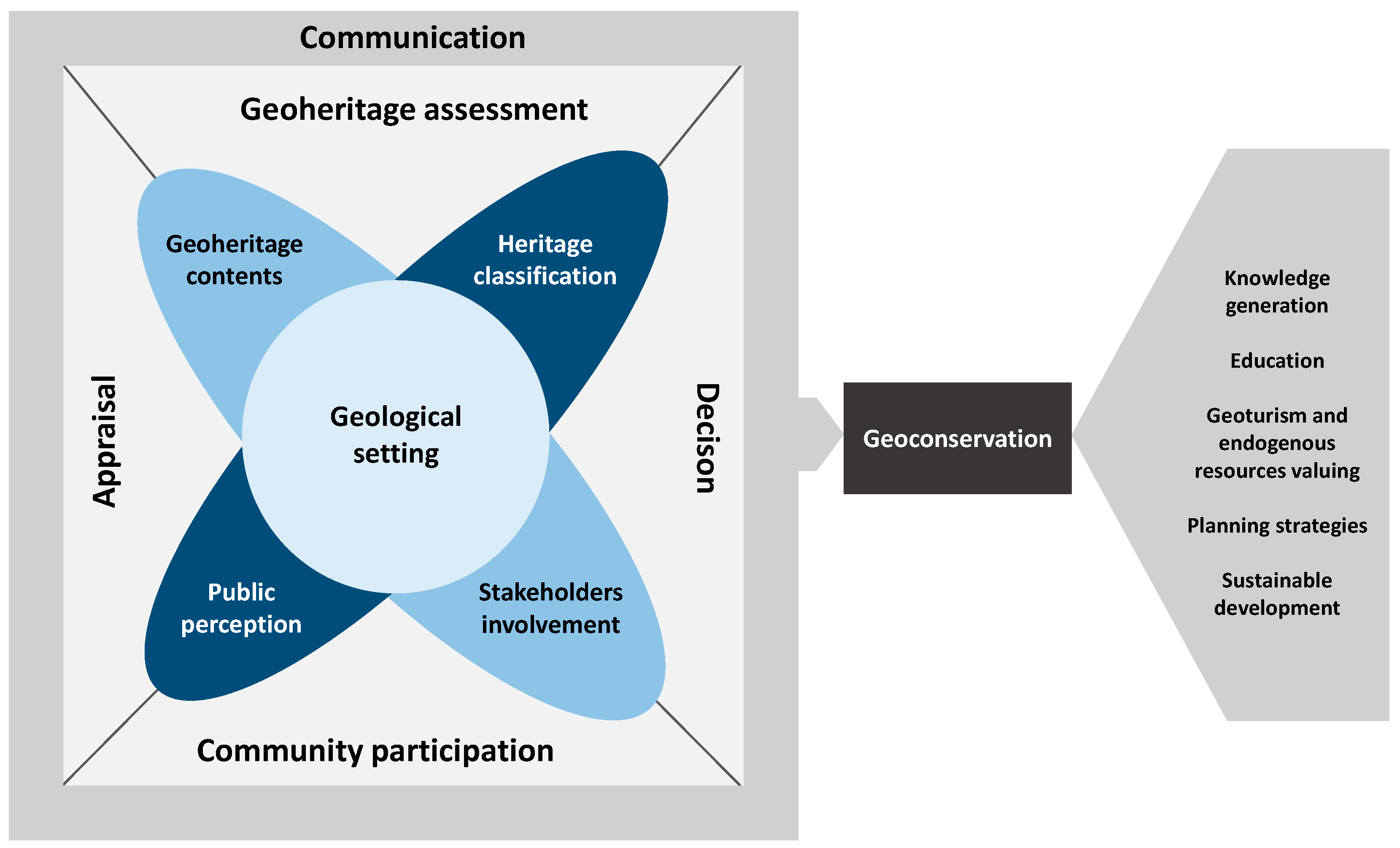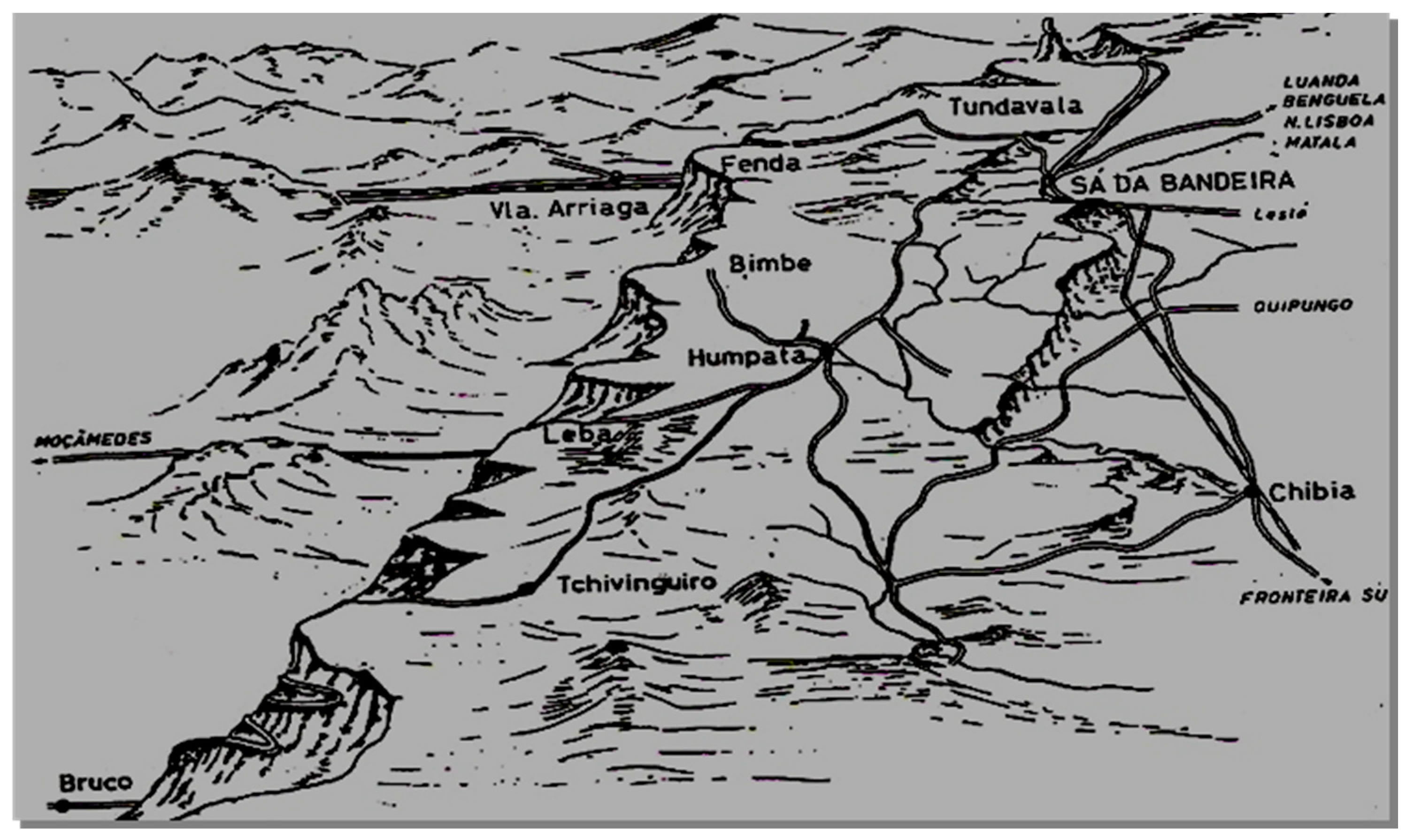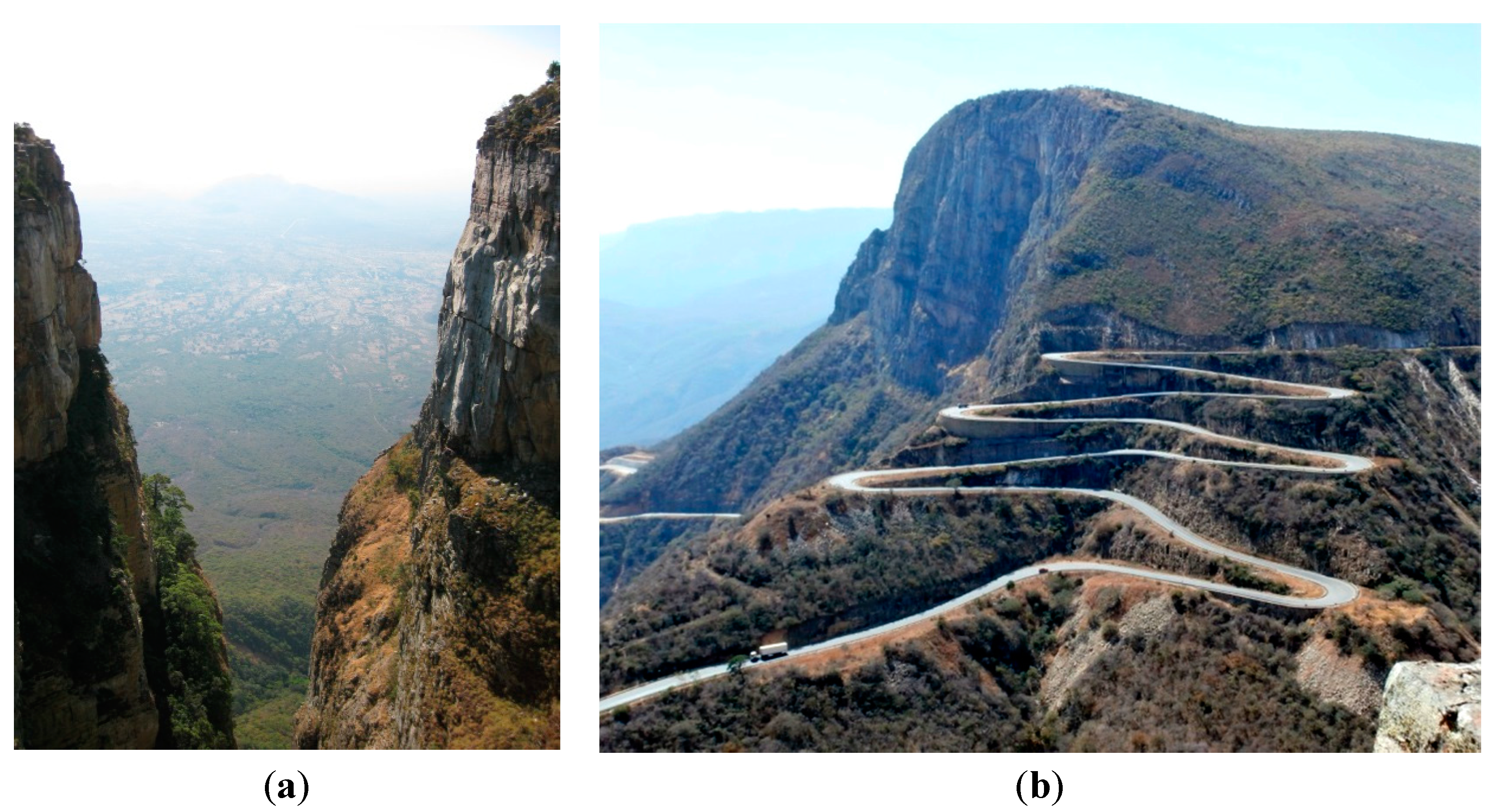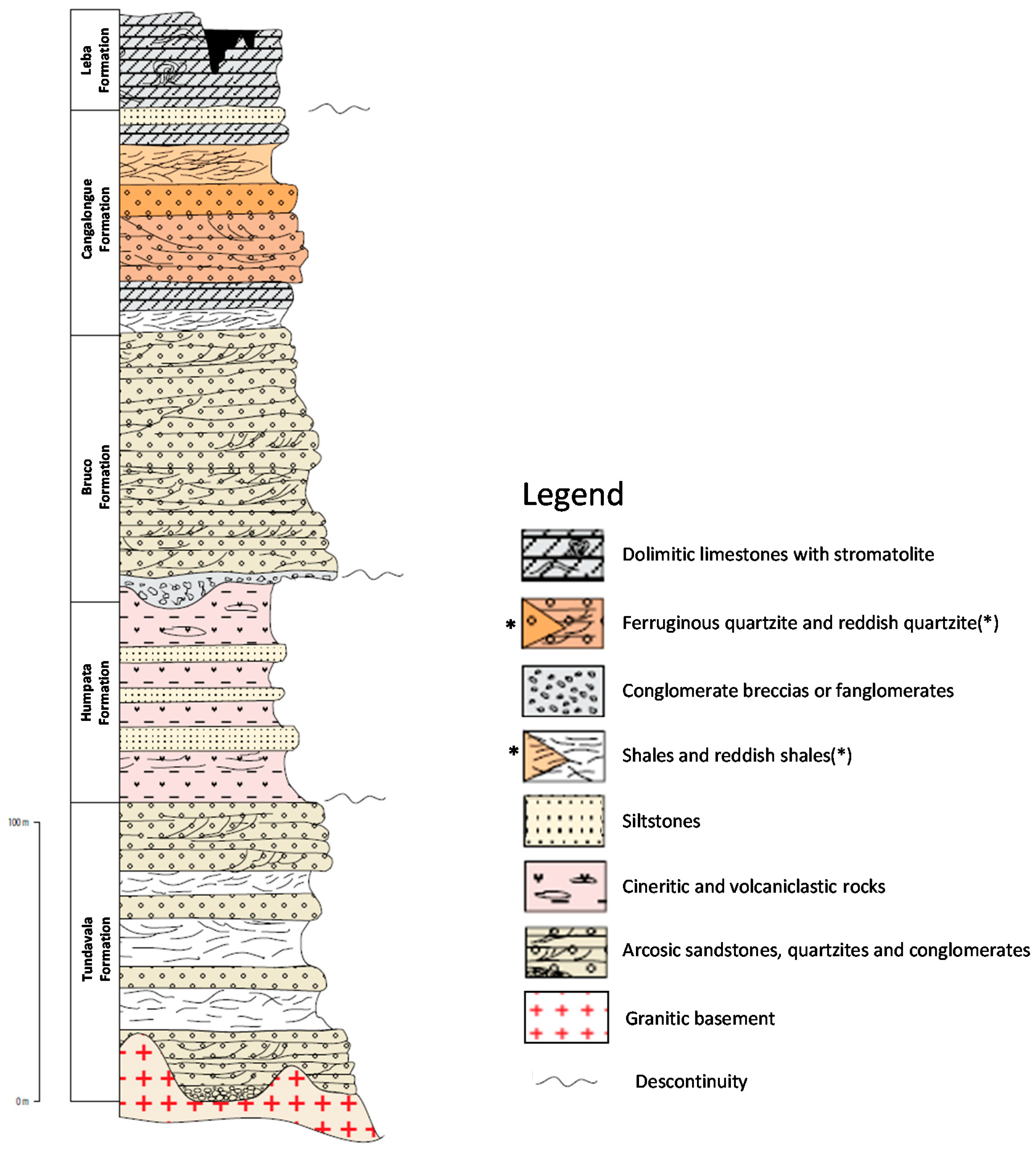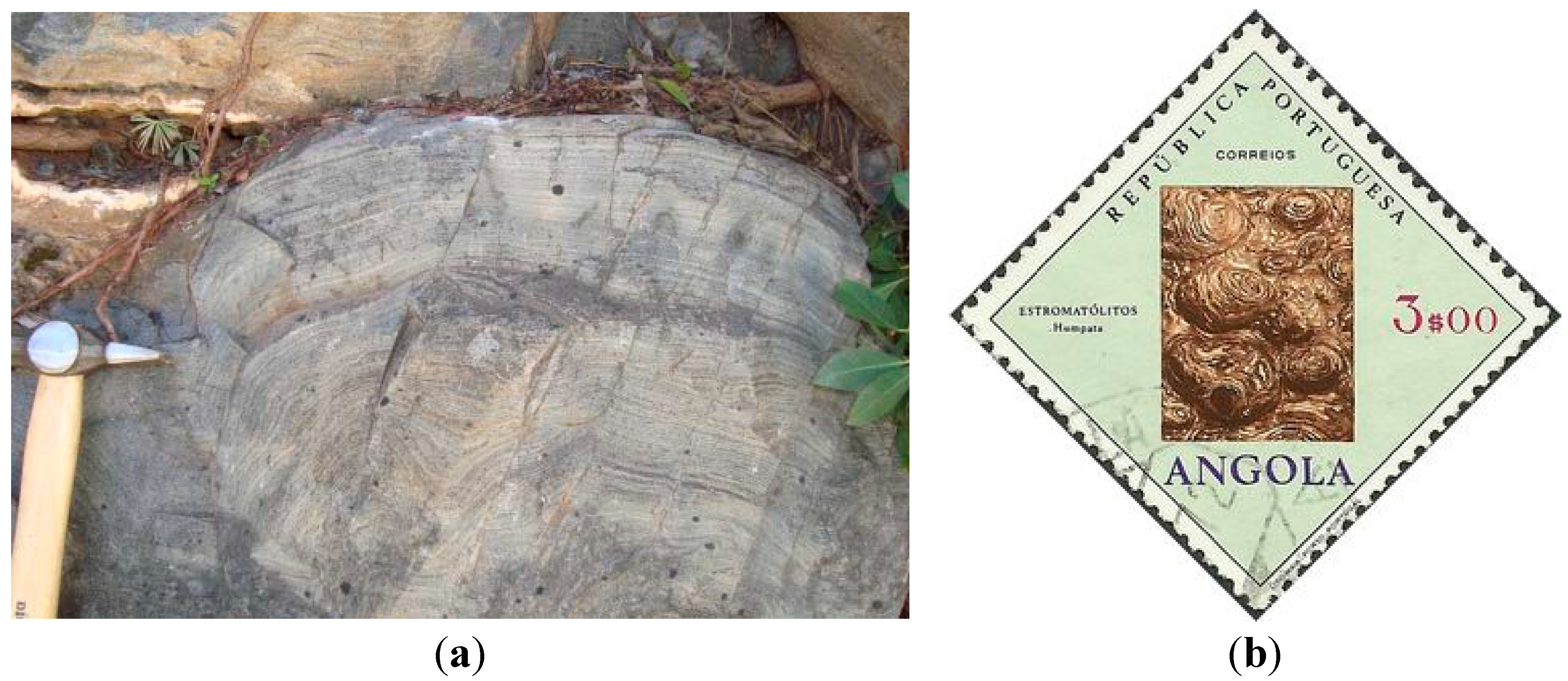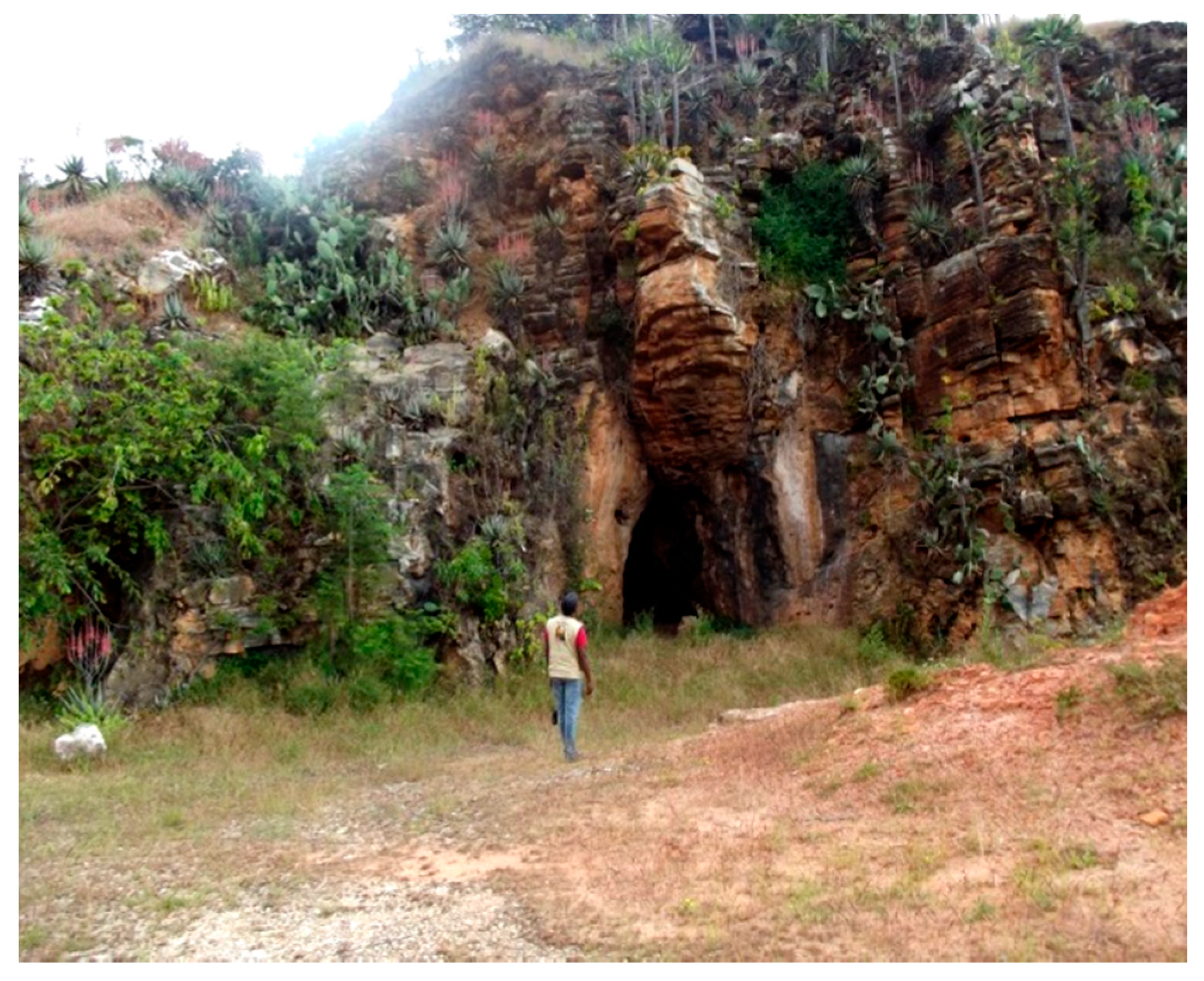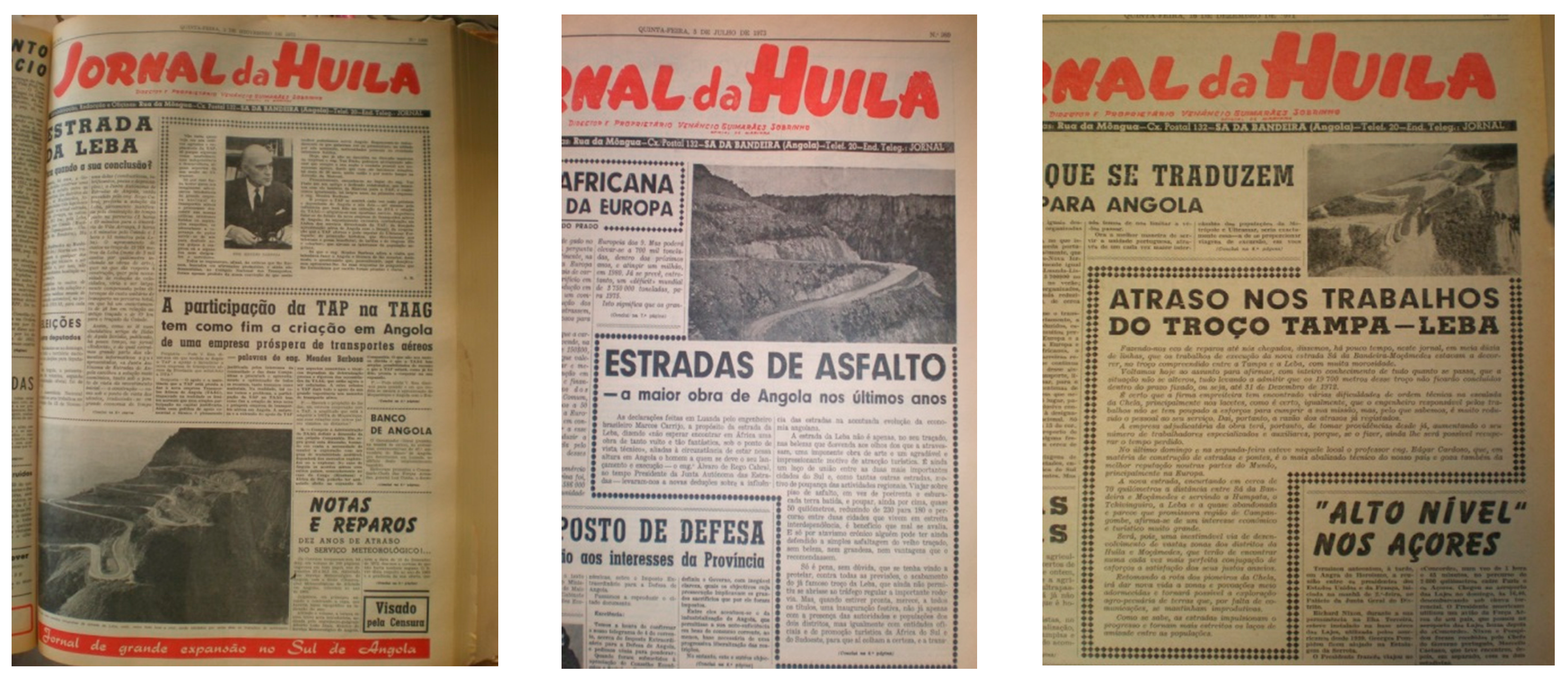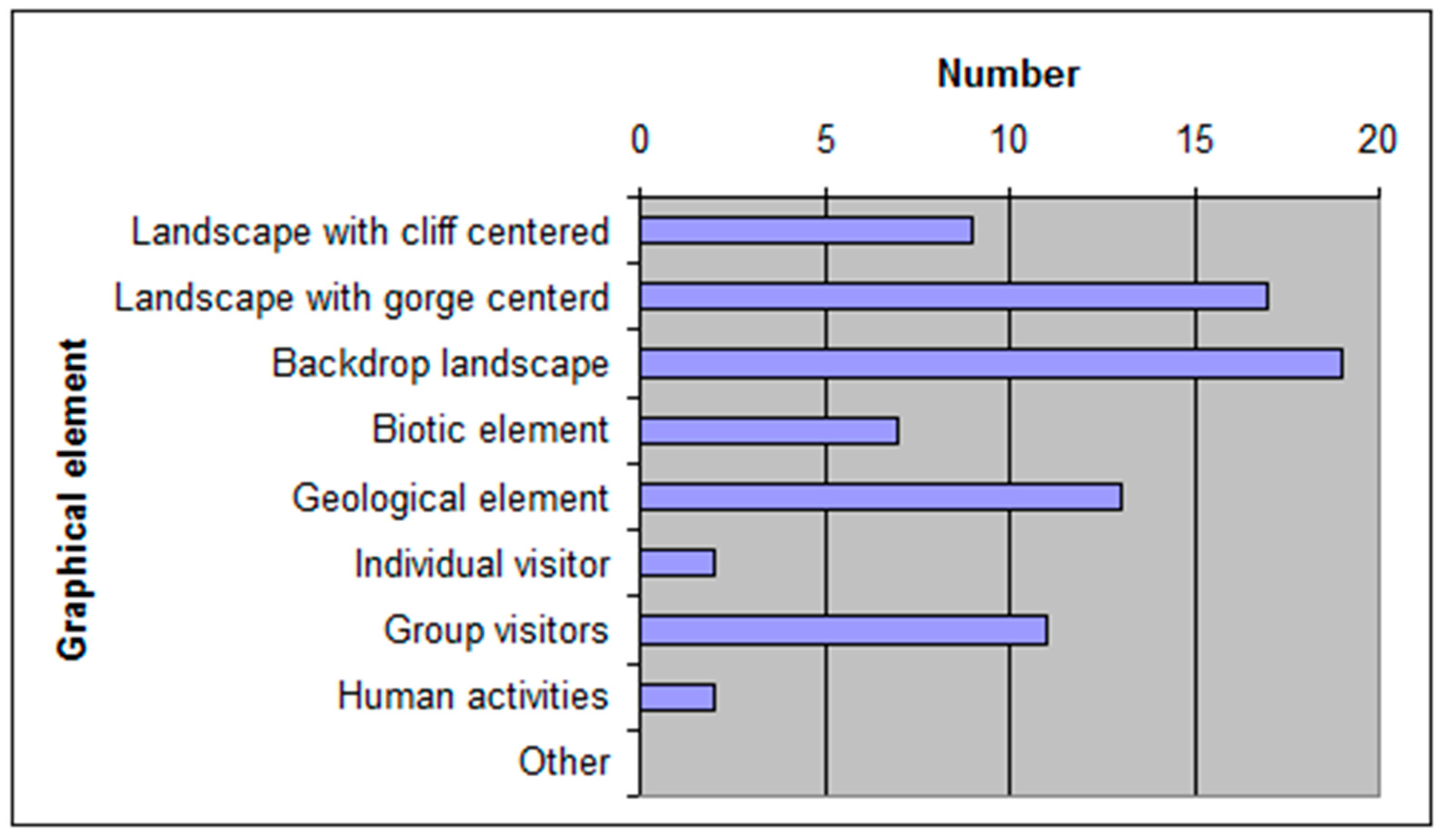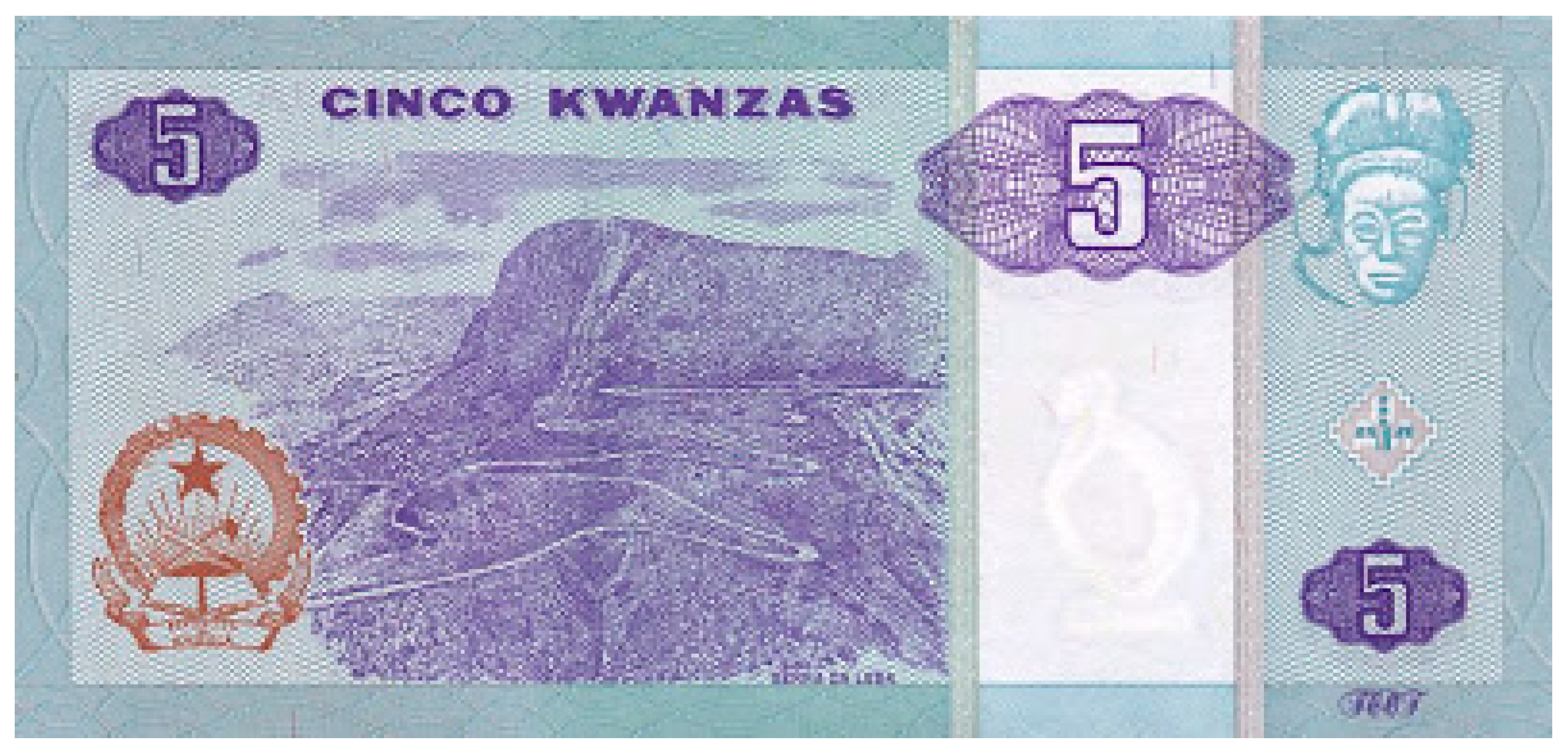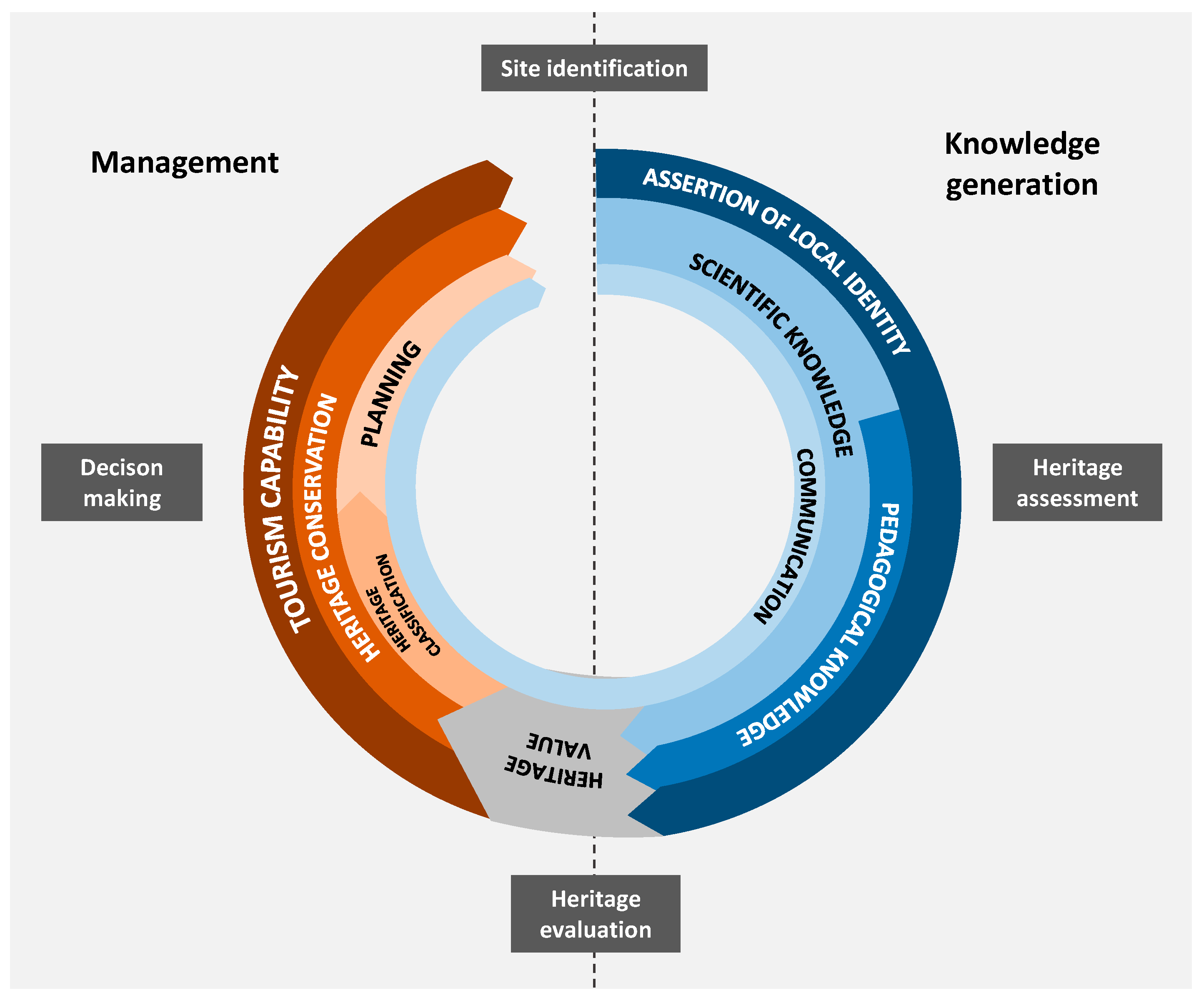1. Introduction and Goals
Several authors highlight the richness of the geological, biological and cultural heritage of Africa, despite the scarce record of such heritage in the World Heritage List of UNESCO (see [
1] and the references therein). When considering the geological heritage of Africa in particular, geoconservation is still quite far from the current political concerns in most of the countries [
2,
3], where no legal frame has yet been developed and/or is scarcely implemented aiming at the preservation of its geoheritage [
4]. Despite the vastness of the territory and the recognition that it includes places with heritage value regarding the abiotic component of nature [
5,
6], there are no national or regional inventories of the geological heritage of Angola, nor any application on the way to the Global Geoparks Network supported by UNESCO [
7,
8,
9].
However, at least the southwestern part of the country is included in an ongoing global initiative, “the African Alive Corridors”, which intends to tell the biography of the continent and to embrace all Africans in its co-curatorship [
10]. Firstly proposed by de Wit and Anderson [
11], the “Corridor 2: Snowball Earth” represents a chapter of the overall story (1000–500 Ma), extending from Angola to Namibia, that is expected to be written by those living either in or near them and based on information recorded in its rocks, fossils and extant flora and fauna, as well as in its archaeological and cultural sites [
10].
This holistic vision regarding the heritage as a whole, including the geological heritage of a territory, is often replaced by sectorial approaches to the cultural heritage, on the one hand, and to the natural heritage, mainly its biotic component, on the other. Moreover, within geoconservation practices,
i.e., inventory, evaluation, conservation, valuation and monitoring procedures applied to geological heritage [
12], several methods and techniques of inventory and evaluation have been proposed, mainly focused on the geological properties of objects and/or sites displaying heritage value (scientific value as argued by Brilha [
13]) without also considering the attributes socially assigned to them [
14].
The community-based approach has been underlined as a key element for co-management of natural conservation strategies and for the support of local equity and empowerment [
15,
16,
17]. Building cohesion, while achieving tangible outcomes, with the increment of self-organization and the capability to better respond to external or internal disruptions, also provides an increase of the general community’s resilience [
18,
19].
Stakeholders represent the entities that can affect or be affected by the geoconservation processes, including the business managers, planners, politicians, NGO leaders and media heads. The stakeholder’s involvement is important for defining strategies recognized by all for the management of natural heritage and to facilitate the mediation of sustainable decisions [
20,
21], as they can make possible effective partnerships between host communities and the authorities, so that local people feel that their heritage represents an attraction [
22]. Community participation makes possible basilar conservation activities, including reliant economic activities with business’s commercial viability, with linkages and multiplier effects on the local economy [
23]. It can also support planning policies and regulation for natural resources management and the achieving of local projects and collective services [
24].
The community involvement in conservation and valuation procedures of the geological heritage is emphasized by all, as community perceptions can help to maintain and protect local geological sites and raise public awareness of environmental matters [
25], but it is generally disregarded in inventory and evaluation procedures. However, inventory and evaluation steps play a decisive role on the implementation of subsequent conservation, valuing and monitoring actions of the geological heritage [
12]. As pointed by Kiernan [
26] (p. 207), “Conservation initiatives may sometimes be perceived by local people as foreign concepts that are irrelevant to their lives, or even an impediment to their betterment, but they can be essential to protecting nature and associated tourism opportunities that can improve local living standards”.
Community involvement in geoheritage inventory and evaluation procedures can be appraised by using a classification system that integrates both the geoheritage properties displayed by the geological objects and usually recognized by geoscientists (
i.e., relevance grade, and the social role attributed to geological objects by communities outside Earth scientists that arise from the public perception of such objects (
i.e., abstract perceptiveness; [
14]). The conservation of a site as a protected area or any other legal instrument is a decision-making process, involving the stakeholders’ appreciation regarding the economic incomes for the region, namely through geotourism [
27,
28], thus creating a benefit for local communities, encouraging commercially-successful and environmentally-sound tourism operations [
29,
30].
The articulation between all of the actors in a framework aiming at the geoconservation of any kind of geological object displaying heritage value, which is represented in
Figure 1, depends on communication effectiveness, a major component in all of the steps of the process, and not only at its final part when active participation is expected of local communities in ensuring the physical integrity of the geological objects. Communication is taken in a broad sense that includes corporate communication, information dissemination, awareness, public sensitization, stakeholders and community involvement. An integrated and continuous communication strategy underlying all options related to geoconservation, supported by educational and research activities, is the best way to ensure the effective protection of natural values, either classified or unclassified [
31,
32], as well as to develop a regional capability building, namely through geotourism. This is a tool for protection, as mentioned by Garofano [
33], providing a source of sustainable economic benefit for the region, and represents an opportunity to manage it in a way that conserves it for the future [
7,
34].
Assuming the relevance of community involvement in geoheritage assessment and conservation processes, in this work, we present two case studies from southern Angola related to key locations for the understanding the Earth’s geological history, where both social and scientific components were taken into account in geoheritage evaluation procedures: Tundavala and Leba geosites (Huíla Province). The resulting conceptual community-based model can be applicable to geoconservation purposes and actions in other African regions committed to the sculpting of the autobiography of the continent and to its co-curatorship for the benefit of future generations [
10].
Figure 1.
Geoconservation process of any kind of geological object displaying heritage value, showing the actors’ involvement for each phase of evaluation. The geoconservation process produces knowledge generation, increases education, promotes geotourism and endogenous resource valuing and develops planning strategies and sustainability.
Figure 1.
Geoconservation process of any kind of geological object displaying heritage value, showing the actors’ involvement for each phase of evaluation. The geoconservation process produces knowledge generation, increases education, promotes geotourism and endogenous resource valuing and develops planning strategies and sustainability.
2. Geological Heritage of the Tundavala and Leba Geosites
The Angola legislation regarding National Heritage (Law No. 14/05 of 7 October 2005) defines it as “the physical formations and biological species or groups of such formations and units of such species that have value from the aesthetic or scientific point of view; geological and physiographical formations and precisely delineated areas which constitute habitat of plant and animal species and have value from the point of view of science or conservation; sites or precisely delineated natural areas that have value from the point of view of science or conservation; sites and scenic places of outstanding natural beauty”. Under this legal frame, the Angola state has declared as protected areas six national parks, one regional natural park, two integral natural reserves and four partial natural reserves, corresponding to 82,000 km
2, or 6.6% of the country, mainly directed towards the conservation of biodiversity and biological heritage, thus strengthening current misconceptions of nature, confusing it with its biological component only [
6]. Despite their geoheritage value and tourist interest, Tundavala Gorge and Leba Mountain are out of any protection status aimed at their geoconservation, despite the recent classification of the Tundavala Gorge as a cultural landscape by the Government of Angola (Executive Decree No. 262/12 of 21 August 2012).
The Tundavala and the Leba geosites are located on the edge of the Humpata Plateau, close to the capital of Huíla Province (Lubango, formerly Sá da Bandeira), in the southwest part of Angola (Coordinates: −14.817479, 13.381504 and −15.077026, 13.234766, respectively;
Figure 2). The Humpata Plateau configures a geomorphological sub-horizontal table form displaying extensive and very imposing cliffs, with about a 1000-meter height, which provides an extraordinary viewpoint of the landscape to the west, over Namibe Province, from several natural belvederes (e.g., Tundavala, Bimbe and Leba;
Figure 3 and
Figure 4).
Figure 2.
Geological map of Huíla and Namibe Provinces (southern Angola) indicating the location of the Tundavala and Leba geosites. Reproduced with permission from the authors [
35].
Figure 2.
Geological map of Huíla and Namibe Provinces (southern Angola) indicating the location of the Tundavala and Leba geosites. Reproduced with permission from the authors [
35].
Figure 3.
Schematic overall view of the Highlands of Huila seen from the south, including the Tundavala and Leba geosites (taken from [
36]).
Figure 3.
Schematic overall view of the Highlands of Huila seen from the south, including the Tundavala and Leba geosites (taken from [
36]).
Figure 4.
The most popular views of the Tundavala and Leba geosites. (a) The Tundavala Gorge observed from the belvedere; (b) the Leba cliff observed from the belvedere.
Figure 4.
The most popular views of the Tundavala and Leba geosites. (a) The Tundavala Gorge observed from the belvedere; (b) the Leba cliff observed from the belvedere.
Besides the aesthetic value that is easily recognizable in Tundavala Gorge and in Leba Mountain, it is possible to identify properties displaying geoheritage value in both geological objects, whose characterization and assessment are crucial to support further conservation and valuation procedures, as will be argued in the present work.
3. Methodology
The principles and methodologies regarding geoheritage assessment have been largely discussed by different authors in the last few years. Panizza [
37], Reynard [
38], Fuertes-Gutiérrez and Fernández-Martínez [
39] and Brilha [
13], among others, privilege quantitative-oriented approaches, while others highlight the inventory incommensurability based on social, aesthetic, economic, educational and functional criteria [
40,
41,
42,
43]. Some studies also point to the paradoxes of dealing with the strategies of conservation and the practical experiences, in the long-term run-up to social-ecological changes [
44,
45].
It is assumed that geoconservation is an emerging geoscience with clear and deep social interrelation [
12], which must be grounded in knowledge and methods developed in different sciences, thus approaching the social sciences of the natural sciences [
10,
25,
38,
46]. Such holistic vision must be taken into account not only in its scope, but also in its methods, including in inventory and evaluation procedures. As such, for the geoheritage assessment of the Tundavala and Leba geosites, the multidisciplinary approach proposed by Pena dos Reis and Henriques [
14] was followed, which aims at integrating both the geoheritage properties displayed by the geological objects (
i.e., relevance grade) and the social role that communities outside Earth scientists assign to them (
i.e., abstract perceptiveness). Qualitative in nature, this open system of geoheritage evaluation is adaptable to various political and social contexts and allows the continuous incorporation of new analytical elements for the same territory and/or the re-assessment of previous analytical elements to enlarged areas, as happens with the geological heritage of the Tundavala geosite. Firstly characterized in a previous work [
6], it is now re-assessed in the frame of the evaluation of the geological heritage of the Humpata Plateau based on two of its emblematic geosites: Tundavala in the northern side and Leba in the southwest border.
The integrated assessment of the Tundavala and Leba geosites was based on qualitative and quantitative methods used in different phases of the research process (
Table 1) and explored by Bala [
47] and Domingos [
48]. They include current instruments used in Earth sciences for outcrop observation and sampling, thus enabling interpretative and descriptive information based on previous knowledge [
49,
50], in the articulation of current instruments applied in social sciences, such as content analysis of verbal, observation and mediated data [
51], and content analysis of texts within their context of origin (academia, agencies, institutions, media, web), following current content analytical rules [
52,
53,
54].
Table 1.
Methods and instruments used in the geoheritage assessment of the Tundavala and Leba geosites.
Table 1.
Methods and instruments used in the geoheritage assessment of the Tundavala and Leba geosites.
| Geoheritage Components | Instruments for the Geoheritage Assessment | Methods |
|---|
| Tundavala | Leba |
|---|
| Geoscientific data | - | Geological study | Field work |
| Analysis of academic documents | Desk work |
| Sociological data | Analysis of technical documents |
| Analysis of web pages |
| Analysis of interviews and surveys |
| - | - | Analysis of newspaper contents |
| Interview applied to local residents regarding intangible cultural elements | Field work |
| Survey regarding the motivations and the frequency for local residents visiting the geosite |
| - | Survey applied to visitors regarding the geotourism potential |
Field work has been carried out both for the geological study of the region and for public inquiring. A set of geological information was collected based on outcrop observation and sampling, in addition to geomorphological and hydrological descriptions and to determine visual indicators representing the landscape values [
55].
Field work was also carried out for surveying local residents and visitors and for interviewing local residents and traditional leaders. Desk work was carried out for the interpretation of field data, the content analysis of different sources (scientific and technical documents, maps, newspapers, web pages, informative flyers, cards, films) and data collected from the interviews and surveys. The field work for the geological study of the area was carried out in two different periods, October 2010, to April 2011, for the Tundavala region, and January to May 2014, for the Leba region, and it was supported by reference literature [
35,
56,
57,
58,
59].
Fifteen academic papers referring to Tundavala or Leba and representing relevant data regarding historical, ethnographic, geographical, climatic, geological, zoological and botanical issues were collected and analyzed, as well as the type of textual content (nominal reference, short note, general or focal point of description) or graphical content (e.g., photos, schemes, maps, drawing representations). Data were analyzed, categorized and classified.
A similar analysis was developed for the technical documents produced from national, regional or local agencies or administrative institutions. Documents related to tourism and environmental issues highlighting the importance of the Tundavala geosite, as well as technical documents and engineering projects related to the Leba site were also collected and analyzed. Taking the importance of the national road EN 280 into account, hemerographic content was also analyzed, namely the regional newspaper “Jornal da Huíla” (10 April 1969 to 5 July 1975). For such a goal, a specific instrument was conceived of aiming at understanding the difficulties of the engineering project execution, related to excavation of rocks, stabilization of slopes and hydraulic and drainage works. This analysis was also essential to assess both the visual impacts caused by the road and the road adaptation to local geomorphological conditions and the accessibility improvements resulting from its construction.
Specific instruments were also designed to analyze webpage content related to Tundavala and Leba and regarding the nature and the architecture of the website and the keywords that could define it [
60,
61]. The type of textual content (scientific, popular, collective or individual memories) or graphical content (photographs, diagrams, animations, movies and similar representations) it included, as well as the recognition of the main element used in the website images (landscape, biotic, geological, geomorphological, hydrological, human or engineering) were also taken into account. Webpage content related to Tundavala was accessed between 13 May 2011 and 27 September 2011 (80 websites in total), and webpage content related to Leba was accessed between 12 March 2014 and 14 September 2014 (55 websites in total).
Non-orientated interviews of local residents and traditional leaders aged over 18 were administrated at both geosites, in order to survey them about cultural elements referring to Tundavala or Leba. In the Tundavala region, 30 individuals were interviewed; in the Leba region, 30 individuals were also interviewed, but 15 of them from the top of the Humpata Plateau and the other 15 from the base of the cliffs, in the Tampa region.
A questionnaire was directly administrated to 30 local visitors aged over 18 at each geosite, and it included two groups of questions: one inquiring about the frequency and the reasons for visiting the Tundavala or Leba geosites, and the other aiming at understanding the visitors’ perceptions about the natural assets that they could recognize in the geosites and their opinions on the need for developing conservation actions.
Given the facilities of the viewpoint, a specific survey was designed and administrated to 30 people (foreigners and national visitors) at the Leba geosite, at two moments between October 2013, and April 2014, in order to identify their perceptions regarding the geotourism potential of the geosite. Visitors were asked about the reasons for visiting the Leba geosite, how often they used to do it, what they knew about the place before visiting it, how they would describe the visit and what geoconservation and tourism actions would they propose for the geosite.
The questionnaire and the survey were directly and intentionally applied and included closed questions and multiple choice questions.
4. Geoheritage Contents and Value
The data obtained from all the above-mentioned analytical instruments were processed in order to identify the type of content that characterizes the geoheritage value assigned to the Tundavala and Leba geosites, according to the integrated qualification and classification system proposed by Pena dos Reis and Henriques [
14]. Geoscientific data grounded the range of the content attributed to the geosites by the scientific communities (relevance grade), whereas the sociological data supported the nature of the public understanding of such content (abstract perceptiveness) [
47,
48]. Geological content with heritage value for the Tundavala and Leba geosites are indicated in
Table 2 and are described in detail in the following section.
Table 2.
Geological content with heritage value for the Tundavala (T) and Leba (L) geosites (in cursive) according to the integrated qualification and classification system proposed by Pena dos Reis and Henriques [
14].
Table 2.
Geological content with heritage value for the Tundavala (T) and Leba (L) geosites (in cursive) according to the integrated qualification and classification system proposed by Pena dos Reis and Henriques [14].
| Relevance Grade | global | - | - | conceptual | - |
| regional | - | documental (T, L) | - | scenic (T, L) |
| local | indicial | - | iconographic (L) | symbolic (T, L) |
| - | material | demonstrative | cognitive | social |
| Abstract Perceptiveness |
4.1. Documental Content
The recognition of documental content in a geosite is usually assigned to scientific communities’ statements, as this content refers to regional-scale content, resulting from deep knowledge of major geological phenomena considered as particularly relevant for the understanding of significant geologic changes assigned to a region [
14]. The edge of the Humpata Plateau defines the boundaries of a volcanic-sedimentary intracratonic basin of the Paleo-Meso-Proterozoic era and, analogous to others located in the Congo Craton [
57], mainly deposited within an interval of 1947–1810 Ma [
58]. It materializes the stratigraphic record for the Chela Group and the Leba Formation, both units deposited in a wide epicratonic basin after the Eburnean tectonometamorphic episode [
35].
Among the Proterozoic sedimentary basins of the Congo Craton, the Chela Group is the westernmost succession of the Craton and is one of the few relatively undeformed basins, thus allowing the reconstruction of a representative stratigraphic column [
57]. Such a record is particularly well exposed along the western edge of the Humpata Plateau, namely at the Tundavala and Leba geosites. They therefore document the earliest historical records of Gondwana, which, in turn, stands out tall in the biography of Earth [
10].
The Chela Group comprises, from the base to top, the Tundavala (consisting of lenticular conglomerates and quartzarenites with crossbedding stratification), the Humpata (volcanoclastic rocks with interbedded siltites), the Bruco (volcanogenic conglomerates at the base, overlapping sandstones and siltstones interbedded with volcanic and conglomeratic levels) and the Cangalongue (alternations of gray argillites, limestones and red arcosarenites) Formations (
Figure 5). The Chela Group is overlapped by the Leba Formation (stromatolitic dolomites with rare intercalations of siltites;
Figure 7 and
Figure 8), and they have been both integrated into the Damara Supergroup of the Damara belt due to the lithostratigraphic similarity (see [
35,
58] and the references therein).
Figure 5.
The stratigraphical column of the Chela Group outcropping at the western Humpata Plateau (modified after [
35,
58]).
Figure 5.
The stratigraphical column of the Chela Group outcropping at the western Humpata Plateau (modified after [
35,
58]).
The Tundavala, Humpata and Bruco Formations are particularly well represented along the cliffs of the Tundavala geosite [
6]; from the belvedere of the Leba geosite and along the EN 280 road, it is possible to access the Bruco, Cangalongue and Leba Formations (
Figure 6). These geosites correspond to a highly demonstrative record of the Chela Group and the Leba Formation, being the type locality for three lithostratigraphic units and, therefore, displaying documental content [
14].
Figure 6.
The stratigraphical record of the Chela Group up the EN 280 road. (a) Eburnean granitoids of the basement; (b) quartzarenites of the Tundavala Formation; (c) volcanoclastic rocks of the Humpata Formation; (d) sandstones and siltstones interbedded with volcanic and conglomeratic levels of the Bruco Formation; (e) red arcosarenites of the Cangalongue Formation, close to the Leba belvedere.
Figure 6.
The stratigraphical record of the Chela Group up the EN 280 road. (a) Eburnean granitoids of the basement; (b) quartzarenites of the Tundavala Formation; (c) volcanoclastic rocks of the Humpata Formation; (d) sandstones and siltstones interbedded with volcanic and conglomeratic levels of the Bruco Formation; (e) red arcosarenites of the Cangalongue Formation, close to the Leba belvedere.
4.2. Iconographic Content
Structures that show a clear relation between a particular natural event and its effects on the geological record fit the concept of iconographic content assignable to geological objects displaying heritage value [
14]. Trace fossils and stromatolites, which correspond to local-scale content, represent such types of structures of biogenic origin, whose interpretation, despite being attractive for the general public, requires specialized knowledge [
62].
The Leba Formation (approximately 60 m thick) is mainly composed of black-colored, laminated dolomitic limestones with abundant stromatolites and increasing chert content towards the top, which was probably deposited in a tidal flat environment with evaporitic conditions [
63] (
Table 3,
Figure 7).
Table 3.
Informal lithostratigraphic units of the Leba Formation and their mainly stromatolitic structures (based on [
63]) (P: planar laminae; LLH: laterally linked hemispheroids, LLH-C: with close lateral linkage, LLH-S: with spaced lateral linkage; SH: vertical stacked hemispheroids, SH-V: with variable basal radius; SS: spherical structures).
Table 3.
Informal lithostratigraphic units of the Leba Formation and their mainly stromatolitic structures (based on [63]) (P: planar laminae; LLH: laterally linked hemispheroids, LLH-C: with close lateral linkage, LLH-S: with spaced lateral linkage; SH: vertical stacked hemispheroids, SH-V: with variable basal radius; SS: spherical structures).
| Leba Formation | Level | Lithological Composition | Main Stromatolitic Structures |
| L6 | Stromatolitic dolo-biolites, chert | LLH |
| L5 | Intra-dolo-microsparite | - |
| L4 | Stromatolitic dolo-biolites | P, LLH-C, LLH-S, SS |
| L3 | Stromatolitic dolo-biolites | SH-V |
| L2 | Sandy-dolo-intra-microsparite | - |
| L1 | Micritic dolo-calcarenite | - |
Figure 7.
Stromatolites of the Leba Formation: (a) laterally-linked hemispheroids displaying spaced lateral linkage in the outcrop (LLH-S-type stromatolites); (b) spherical structures in the philatelic record (SS-type stromatolites) included in a commemorative collection of the Portuguese Post on the geology of Angola, issued in 1970.
Figure 7.
Stromatolites of the Leba Formation: (a) laterally-linked hemispheroids displaying spaced lateral linkage in the outcrop (LLH-S-type stromatolites); (b) spherical structures in the philatelic record (SS-type stromatolites) included in a commemorative collection of the Portuguese Post on the geology of Angola, issued in 1970.
The occurrence of stromatolites in SW Angola was firstly reported by Vasconcelos [
64], who related those microbial structures to the form-genus
Collenia, ranging from types resembling
C. undosa, Walcott, to more complex forms, and who highlighted its probable correlation with those of Otavi in the adjacent territory of southwest Africa. More recently, several authors have reinforced the correlation between the Leba Formation and the Tchamalindi Formation (Angola) and the Tsumeband Subgroup and Otavi Group outcropping in Namibia [
35,
58,
65], possibly Vendian in age [
66,
67].
4.3. Symbolic Content
Symbolic content can be recognized in highly socialized geosites largely used by the public due to reasons other than geological ones, such as historical or geographical ones, which can contribute to attracting people to visit them [
14]. The symbolic content assignable to the Leba and Tundavala geosites was assessed through interviews with local residents aiming at identifying traditions and expressions, namely folk tales, fables, proverbs, rhymes, songs, prayers and chants, related to the geosites and somehow representative of their identity.
The Humpata region is occupied by descendants of the Bantu people, which have their origin (3000–1500 BC) at the Adamawa Plateau (Cameroon), from which they colonized southern and eastern Africa, reaching Angola by 1000 BC [
10]. Today, two ethnic groups can be recognized in the study region, one who lives in the highlands of the Humpata Plateau (the Nyhaneka) and one who lives on the bottom of the mountain (the Mucubal, a variant of the Herero group), holding relations of peaceful coexistence. From the nineteenth century, Europeans settled the region, attracted by the mildness of its climate and the fertility of the soils [
68].
The word “
Tundavala” comes from the local people’s perception of the natural features of the region, expressed in the original Nyhaneka term “
Ntandavala”, which means: “what was attached/shrunken and stretched”, “what is open/apart”, “the aperture” or even “the space left by two sides”. The sharply relief of the Serra da Chela has clearly affected the perception of the region, creating a popular belief of the existence of a supernatural power in the Tundavala cliffs and gorge: They can offer peace to the visitors, but they can also produce concern, thus giving rise to the myth that the place can only be visited by older people. The Tundavala region is also associated with fertility in the folk tales, but visiting the Tundavala admits other less optimistic symbolic representations, related to the inability to move forward beyond the cliff “where it ends the ground/place we tread” [
6,
47].
The word “
Leba” derives from the word “
Eleva” that, in the national Nyhaneka language, means “cave” [
69], mainly in the sense of refuge given the morphological characteristics of the region and the constraints on access and movement (
Figure 8). Besides its relation with the karst structures that characterize the dolomitic lithotypes that outcrop in the uppermost part of the plateau (Leba Formation), the term “
Leba” and the corresponding geosite were evoked in the interviews as theme songs and as passage (“
efiko”) and circumcision rituals (“
ekuendje”). Other intangible cultural elements recognized by the vast majority of local respondents living at Tundavala and Leba geosites are transcribed in
Table 4, which include chants, prayers, proverbs and traditional tales [
48].
Figure 8.
Cave, or “Eleva” in the national Nyhaneka language, resulting from the dissolution of the dolomitic lithotypes that compose the Leba Formation, located in the uppermost part of the Humpata Plateau.
Figure 8.
Cave, or “Eleva” in the national Nyhaneka language, resulting from the dissolution of the dolomitic lithotypes that compose the Leba Formation, located in the uppermost part of the Humpata Plateau.
Table 4.
Intangible cultural elements identified for the Tundavala and Leba geosites according to the interviews through interviews with local residents.
Table 4.
Intangible cultural elements identified for the Tundavala and Leba geosites according to the interviews through interviews with local residents.
| Cultural Representations | Geosite |
|---|
| Chant: “Tuayile keleva, konongongo, konompunda, belikuama tuayile keleva” (We went to Leba, to the high mountains and to the higher elevations, we went to Leba) | Leba |
| Chant: “Ondjiva yokeleva yipuilisa yetesa omatuanyonga, Ondjiva yokeleva yipuilisa” (The path of Leba is tiring, causes dizziness, the way of Leba is tiring…” | Leba |
| Chant: “Koviponda ponda tuayile koviponda ponda keleva koviponda ponda…” (We went to the curves of Leba, we went to the curves of Leba) | Leba |
| Prayers: “kukambetaili okamono lucito kalumoneka olukavamjawa kokatala kombeki alucapupulwa kocela” (Do not hit my child, because to become fertile, we have to go into the opening of the sacred mountain of Chela and then go to the Katala hospital) | Leba and Tundavala |
| Folk tales: The Tundavala forms (gorge and scarp) are the result of the vengeance of a god who could not dominate the world | Tundavala |
| Chants: “Ko Ntandavala mepunnyu lyo mepunda elundu manya lipola ohunga ovaluvango, litalaleka nomeva omapya onananKono” (The Tundavala is the water coming from the mountain rocks, which quenches the thirst of the people and irrigating the fields) | Tundavala |
| Proverb: “Lipundica ny kuyakule, thandavala ny kueleke” (Leave the cliff without aura, and just take the luck into account) | Tundavala |
| Chant: “Ompunda Yokwatandavala”, dedicated to female fertility | Tundavala |
The descent from Leba through the EN 280 road enables the connection between the inland areas of the Huíla Province and the Atlantic coast of the Namibe Province. However, at the same time, this important infrastructure allows the public use of the impressive landscape of the western border of the Humpata Plateau, cut by the serpentine road, which is a 20-km art work, with 19 spectacular curves. The project limitations and difficulties of construction (late 1960–early 1970 decades), due to excavation, landfill and hydraulic works, resulting from the morphology and geology of the site where the road was located, were profusely reported in the weekly newspaper “Jornal da Huíla”. The hemerographic analysis of its content highlight the technological and engineering dimensions of the construction of the road, the relevance of the connectivity and mobility of people and goods between the provinces of Huila and Namibe, as well as the economic, tourist and political impacts resulting from its use. The different stages of the road construction were used by the Portuguese colonial regime as an important propaganda tool, as can be seen by the frequency with which the subject appears in the front pages of the newspaper (
Figure 9).
Figure 9.
Front pages of the weekly newspaper “Jornal da Huíla”, showing the social relevance assigned to the construction of the EN 280 road (1969–1975).
Figure 9.
Front pages of the weekly newspaper “Jornal da Huíla”, showing the social relevance assigned to the construction of the EN 280 road (1969–1975).
4.4. Scenic Content
Unusual geomorphological features producing outstanding landscapes that provide high recreational function to the public typify the scenic content assigned to a geosite [
14]. Both Tundavala and Leba geosites were selected for the election of the “7 Natural Wonders of Angola” (categories “cliffs” and “great reliefs”, respectively), the first one being the winner in its category [
70].
In order to assess the landscape value of the Tundavala and Leba geosites, different instruments were applied to analyze: the textual and graphical contents from technical documents; the textual and graphical contents from web pages; the content of local residents’ survey; the content of visitors’ survey.
4.4.1. Textual and Graphical Contents from Technical Documents
Technical documents about Tundavala are mainly focused on tourism promotion and environmental issues. In most of the cases, there is only a nominal reference to Tundavala, although a significant number of publications may refer to it within a broader approach or even as a central element of a small description. Several keywords were identified whose frequency emphasizes the association of Tundavala with adjectives, such as “imposing” or “tourism”, and the noun “gorge”. The graphical content analysis highlights the relevance of the photographic image (48 records), to the detriment of other types of representations. The pictures of the landscape are clearly dominant (38 records in comparison to the 12 representations of other elements, such as rocks and geomorphological forms, wildlife and flora) [
6]. Technical documents about Leba can be organized into two groups: one related with tourism information, which highlights the overview of Leba Mountain and the road from the belvedere located at its top, and the other related to the difficulties in the construction of the EN 280 road (
Figure 4).
4.4.2. Textual and Graphical Contents from Web Pages
The analysis of the textual content of public websites referring to Tundavala has enabled the recognition of 246 keywords valuing environmental issues, scenic quality, economical potential, among others, being “tourist” (47 records), “gorge” (37), “natural monument” (14), “landscape” (12), “war” (nine) and “mountain” (eight) the most representative keywords, all highlighting its scenic content and its touristic potential at different scales (national, provincial and local) and sometimes associated with individual and collective memories [
6]. The analysis of the graphical elements included on web pages underlines the photographic representation (45 records), movies (26), animation (eight) and schemes (one), the landscape being the most represented feature, followed by particular geological or geomorphological elements and visitors’ activities (
Figure 10).
Figure 10.
Frequency of graphic content included in web pages referring to Tundavala.
Figure 10.
Frequency of graphic content included in web pages referring to Tundavala.
The analysis of textual content of public websites referring to Leba has enabled the recognition of 99 keywords, “road” (40 records), “Serra da Leba” (27), “curves” (15), “viewpoint” (nine) and “photography” (eight) being the most representative ones, thus emphasizing the social relevance of the EN 280 road, besides other references related to the geosite, such as historical, geographical and environmental features. The analysis of the graphical elements stresses the relevance of photos (48 records), to the detriment of other types of representations (eight animations, four movies, two schemes, one stamp and one bill;
Figure 7b and
Figure 11), the road being the central element of most of them (29 records), followed by specific landscape elements, such as the details of the geological materials and forms (17) and hydrographic aspects associated with the waterfall (two). The great majority of the representations is focused on the landscape (48 records), often representing collective or individual memories of private or official visits.
The analysis of the textual and graphical content from web pages referring to the Tundavala and Leba geosites can therefore testify to the value of their scenic content. At both geosites, the scarce human occupation and developing traditional activities that do not endanger the harmony between people and nature [
14] can represent an attractive geotourism resource for promoting sustainable rural and economic development in this African region [
71].
Figure 11.
Notaphilic five kwanza item issued by the National Bank of Angola, showing the Leba cliff and the EN 280 road.
Figure 11.
Notaphilic five kwanza item issued by the National Bank of Angola, showing the Leba cliff and the EN 280 road.
4.4.3. The Content of Local Residents’ Survey
The content analysis of surveys carried out with local residents of both geosites has reinforced their landscape value, in particular the imposing view from the belvederes, which provides a broad view over Namibe, located to the west. Local residents from Leba also point out the relevance of the EN 280 road for south Angola. When asked about the frequency of visits to Tundavala and Leba, the majority of local residents said that they visit the geosites at least once a year and generally monthly. However, the reasons for visiting are different for the two sites: while for Tundavala, respondents have indicated mainly leisure reasons, for Leba, the motivations are mostly related to travel home/work, to casual reasons or to travel between provinces, with only five (of a total of 30) respondents invoking family and recreational reasons.
6. Conclusions
The African continent is a geological paradise for its geodiversity and richness of natural resources [
83]. With 1,246,700 km
2 in area, Angola has in its territory geodiversity resources of scientific value (geosites
sensu Brilha [
13]), although there is, to date, no national inventory of such places. Moreover, some of them are “even more attractive as their geographical, historical, architectural and traditional frameworks are truly outstanding” [
4] (p. 4).
This work describes two case studies regarding the geoheritage value of two emblematic geosites located in southern Angola (Huíla Province)—the Tundavala and Leba geosites—where both social and scientific components were taken into account in geoheritage evaluation procedures by following the multidisciplinary approach proposed by Pena dos Reis and Henriques [
14], which aims at integrating both the geoheritage properties displayed by the geological objects (
i.e., relevance grade) and the social role that communities outside Earth scientists assign to them (
i.e., abstract perceptiveness).
Several methods and instruments were designed for the geoheritage assessment of the Tundavala and Leba geosites in order to ground the above-mentioned geoheritage components (relevance grade and abstract perceptiveness) and to operate with data of a geoscientific and sociological nature. They include: the geological study of the area; the analysis of the textual and graphical content of academic documents, technical documents, web pages and hemerographic resources; the analysis of data collected from interviews and surveys applied to local residents to identify their perceptions regarding intangible cultural elements related to the geosite, to local residents to identify the motivations for visiting the geosite and the frequency of visits and to visitors to identify their perceptions regarding the geotourism potential of the geosite.
The results show that the Tundavala and the Leba geosites display geoheritage value with local relevance based on the recognition of its symbolic content, provided by intangible cultural elements that are locally identified. At the Leba geosite, it was also possible to recognize iconographic content derived from its paleontological record. In addition, both geosites display documental content, recognized by the geoscientific communities, and scenic content, provided by the social role that communities outside Earth scientists assign to them, both of regional relevance.
The community-based geoheritage assessment of the Tundavala and the Leba geosites supports the implementation of subsequent management measures, requiring decision actions able to promote local equity and empowerment. The resulting geoconservation model, based on knowledge generation and management and grounded in communication and stakeholder involvement, enhances natural conservation strategies and, therefore, the territorial capabilities. Cyclical and retro powered in nature and framed in an open system of assessment of geological heritage, the model enables continuous monitoring and review actions. As such, it can be adjusted to geoconservation purposes and actions in regions displaying different geological and societal scenarios.
By highlighting the role of local communities and actors’ involvement in all of the geoconservation processes, this model is particularly appropriate for the achievement of the main goals of ongoing initiatives aiming at the improvement of the situation regarding geoheritage in Africa, like the African Geoparks Network [
4], and/or at drawing the biography of the continent from its oldest foundations to the present, viewed from its geological, biological and cultural perspectives, like the “African Alive Corridors” [
10].
